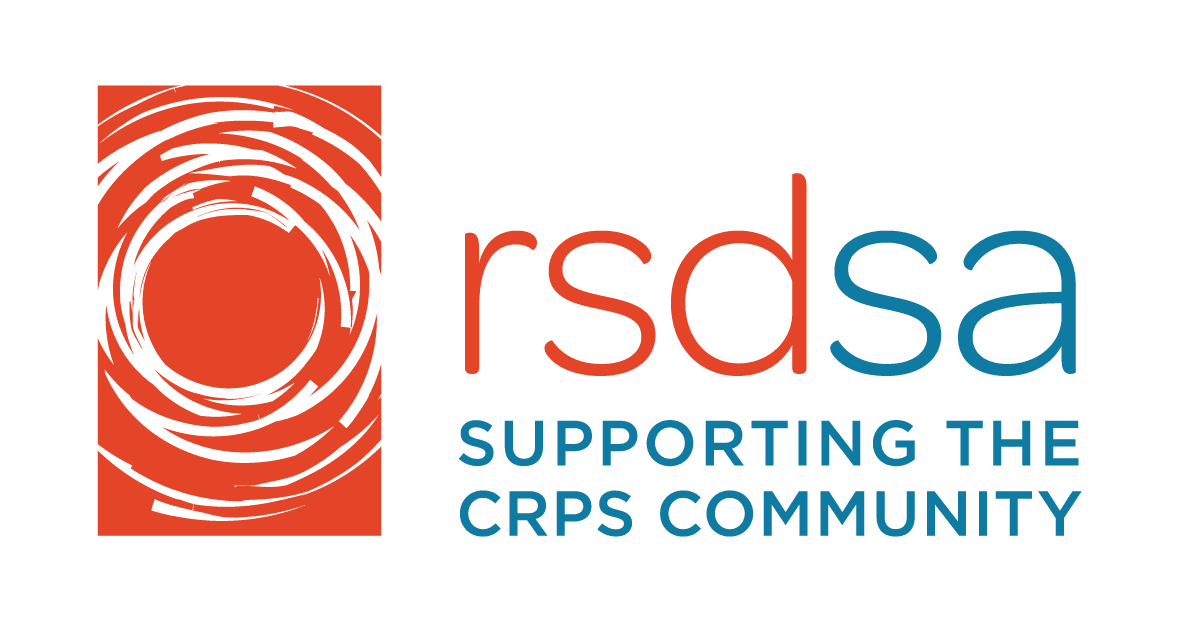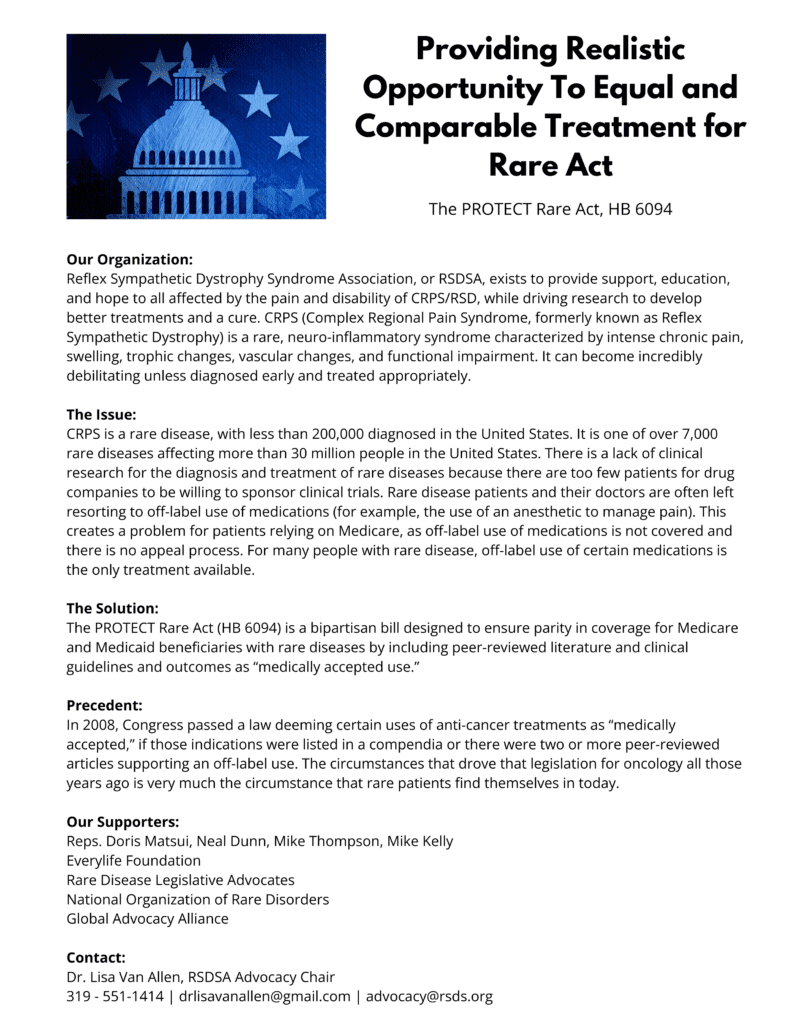Written by Lisa Van Allen, Chair of the RSDSA Advocacy Committee, for the RSDSA blog.
Advocating for Yourself
When I think of advocacy, my mind generally goes to things like letter writing campaigns and meetings with legislators. After all, advocacy is defined as “pleading on someone’s or some cause’s behalf”. Before advocacy can truly be effective we need to learn to advocate effectively for ourselves.
Self-advocacy is the ability to communicate what your needs are.*It’s being able to describe your condition concisely while knowing you owe no one an explanation.*It’s partnering with medical providers in finding the best course of treatment for your specific needs. *It’s being informed and confident when dealing with bureaucracies like insurance companies and health care systems. *It’s having healthy boundaries with family and friends, so you can say no without guilt, please without shame, and thank you with true gratitude.
Over the next few weeks I’ll be writing on each of these subjects with the goal of empowering all of us to better advocate for ourselves. RSD/CRPS is painful enough without the stress and heartache caused by unmet needs.
10 Tips to Patient Advocacy
What is self-advocacy? When living with chronic pain, long-term illness, or a disability, it is often necessary for individuals to advocate for themselves in order to receive the care and resources they need. This may include advocating for themselves with physicians, employers, hospitals, pharmacies, or other groups, such as disability resource offices. Successful self-advocacy ensures needs are identified, personal goals are set, and concerns are shared. Additionally, it can build confidence, ensure informed health care decisions are made, and secure control of ongoing self-care.
What is patient advocacy? Patient advocacy is defined as protecting the interest of a patient through various means, including defending their rights, protecting against inadequate health care, providing support (e.g., financial, legal, emotional, etc.), and contributing to health care decision-making. A patient advocate may also provide caretaking, assist in the navigation of the health care system, and promote patient protection. There may be times when self-advocacy is not enough and finding support from a patient advocate is necessary. Hospitals frequently have patient advocates on staff, and you can also find freelance patient advocates who will support someone faced with a complex medical or legal bureaucracy. However, a patient advocate could also simply be a friend or family member who has been informed of the needs and challenges faced by a patient and has stepped up to support them in getting their needs met.
Becoming your own health care advocate Self-advocating can be intimidating; however, there are several ways to ensure it is a simple and successful task. These include, but are not limited to, the following:
1. Know your rights. Individuals with chronic conditions or disabilities have equal rights that are protected by law. Understanding these rights is essential for successful self-advocacy. Individuals can research these rights themselves or with the help of a lawyer or professional patient advocate.
2. Keep detailed records. Documentation, such as diagnoses, medications, treatments, test results, specific accommodation documents, and medical letters, should be readily available. Keeping these records organized and easily accessible is vital. Many health care systems and medical offices offer online portals or apps where individuals can view their appointments, prescription refill requests, vital signs, test results, and other important information. It is also helpful to obtain a CD of any MRI’s or CT scans. This allows individuals to be committed to their health care by reviewing this information, asking questions when needed, or pointing out inconsistencies or errors.
3. Prepare ahead of time. Prior to appointments or meetings, individuals should know their goals and desired outcomes. Specific needs and discussion topics should be prioritized in case time is limited. Advanced preparation can ensure appointments and meetings are productive, while also reducing nervous energy.
4. Ask questions. Individuals should ask questions to help avoid misunderstandings. They should never be ashamed of asking questions or requiring explanations. If a provider does not have an adequate answer, ask who is the best person to get the information you need. Frequently nurses are an excellent source of information and can guide you to the right people for answers.
5. Do research. Individuals who are able should research their diagnoses, treatment options, needed tests, future procedures, and medications. This can be done at a local library or online using only reliable and professional websites. A provider may offer a reliable website for research purposes. This can help individuals understand medical terms used by professionals or the aspects of treatment described.
6. Be assertive. While self-advocating, individuals should be active listeners, focusing on what a provider is saying rather than mentally preparing questions while the provider is speaking. They need to avoid letting emotions overwhelm the situation. They should not be afraid to voice their concerns if they disagree with a statement or decision. They should remain calm but also be firm.
7. Get information in writing. The process of writing helps the brain retain information. Sharing information in writing also helps ensure all parties are in agreement. Written documentation is good to have for future reference. Other options include asking if the provider is willing to have the appointment recorded (depending on the legal status of recording in the area), or take a family member or friend as a note-taker.
8. Believe in yourself. Individuals know what they need. The patient is most often the best source of information about what is going on in their body. Confidence is an essential part of self-care and advocacy.
9. Practice the three P’s. If phone calls or messages are not being returned or requests are not being fulfilled, individuals should practice the three P’s: being PATIENT, being PLEASANT, and being PERSISTENT. Medical professionals need a reasonable amount of time to respond to messages and requests. However, if an excessive amount of time has passed, individuals should politely and pleasantly repeat the request or ask if there is someone else who can assist them. Individuals should persist until the need is met.
10. Consider this relationship as a partnership. Most providers truly want to see their patients health improve. Avoid adversarial comments and attitudes. Give your provider the respect they deserve, and expect to be treated with respect and dignity. When you come to a provider prepared and equipped to have an informed discussion, you will see a difference in how you are treated and how the quality and effectiveness of the appointment improves.
Sources: WebMD, U.S. Pain Foundation

